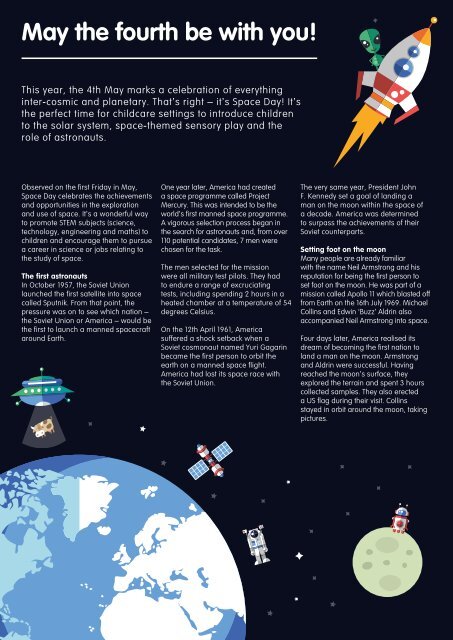Parenta Magazine May 2018
You also want an ePaper? Increase the reach of your titles
YUMPU automatically turns print PDFs into web optimized ePapers that Google loves.
<strong>May</strong> the fourth be with you!<br />
This year, the 4th <strong>May</strong> marks a celebration of everything<br />
inter-cosmic and planetary. That’s right – it’s Space Day! It’s<br />
the perfect time for childcare settings to introduce children<br />
to the solar system, space-themed sensory play and the<br />
role of astronauts.<br />
Space-themed activities you can try in your setting<br />
Ready to inspire the next generation of little astronauts with the wonders of space? Why not<br />
have a go at some of the following activities:<br />
Observed on the first Friday in <strong>May</strong>,<br />
Space Day celebrates the achievements<br />
and opportunities in the exploration<br />
and use of space. It’s a wonderful way<br />
to promote STEM subjects (science,<br />
technology, engineering and maths) to<br />
children and encourage them to pursue<br />
a career in science or jobs relating to<br />
the study of space.<br />
The first astronauts<br />
In October 1957, the Soviet Union<br />
launched the first satellite into space<br />
called Sputnik. From that point, the<br />
pressure was on to see which nation –<br />
the Soviet Union or America – would be<br />
the first to launch a manned spacecraft<br />
around Earth.<br />
One year later, America had created<br />
a space programme called Project<br />
Mercury. This was intended to be the<br />
world’s first manned space programme.<br />
A vigorous selection process began in<br />
the search for astronauts and, from over<br />
110 potential candidates, 7 men were<br />
chosen for the task.<br />
The men selected for the mission<br />
were all military test pilots. They had<br />
to endure a range of excruciating<br />
tests, including spending 2 hours in a<br />
heated chamber at a temperature of 54<br />
degrees Celsius.<br />
On the 12th April 1961, America<br />
suffered a shock setback when a<br />
Soviet cosmonaut named Yuri Gagarin<br />
became the first person to orbit the<br />
earth on a manned space flight.<br />
America had lost its space race with<br />
the Soviet Union.<br />
The very same year, President John<br />
F. Kennedy set a goal of landing a<br />
man on the moon within the space of<br />
a decade. America was determined<br />
to surpass the achievements of their<br />
Soviet counterparts.<br />
Setting foot on the moon<br />
Many people are already familiar<br />
with the name Neil Armstrong and his<br />
reputation for being the first person to<br />
set foot on the moon. He was part of a<br />
mission called Apollo 11 which blasted off<br />
from Earth on the 16th July 1969. Michael<br />
Collins and Edwin ‘Buzz’ Aldrin also<br />
accompanied Neil Armstrong into space.<br />
Four days later, America realised its<br />
dream of becoming the first nation to<br />
land a man on the moon. Armstrong<br />
and Aldrin were successful. Having<br />
reached the moon’s surface, they<br />
explored the terrain and spent 3 hours<br />
collected samples. They also erected<br />
a US flag during their visit. Collins<br />
stayed in orbit around the moon, taking<br />
pictures.<br />
¥ ¥ Create a space station in your role play area, complete with space suits, a control centre<br />
and walkie-talkies<br />
¥ ¥ Using rolled up balls of tin foil, create ‘moon rocks’ which your babies can throw,<br />
squash and play with<br />
¥ ¥ Challenge the children to create their own rovers and moon landers using cardboard<br />
boxes, egg cartons and other recycled materials<br />
¥ ¥ For a sensory experience, dim the lights in one room and get a projector to reflect stars<br />
around the walls and ceiling<br />
¥ ¥ Print off some simple star constellations and have your children recreate them on black<br />
paper using star stickers. Once the basic shape is in place, have the children use white<br />
chalk to draw lines between the stickers to show the shape of the constellation<br />
¥ ¥ If you’re within easy travelling distance of Leicester, why not take a visit to the National<br />
Space Centre? It has the UK’s largest planetarium and a 42-metre high rocket tower<br />
¥ ¥ Let children create their own astronaut and alien masks. Once they’re complete, have<br />
them try ‘space-walking’ around the room<br />
¥ ¥ Encourage children to build and decorate their own space rockets<br />
¥ ¥ If costs allow, consider hiring a mobile planetarium with an experienced astronomy<br />
specialist to answer all the children’s questions<br />
¥ ¥ After talking to children about the moon’s surface (colour, craters, mountains, etc.),<br />
challenge them to make their own model moonscape. Use small rocks to make craters<br />
from ‘asteroids’ crashing into the surface<br />
Are you planning on celebrating Space Day in your setting?<br />
Share your stories and photos with us at marketing@parenta.com!<br />
12 <strong>Parenta</strong>.com <strong>May</strong> <strong>2018</strong> 13

















